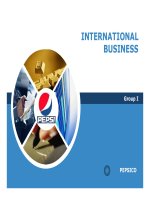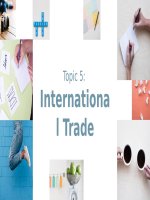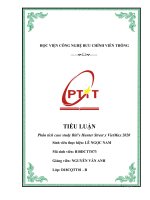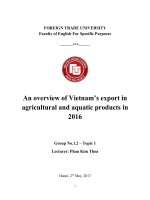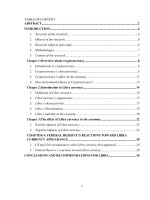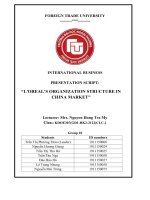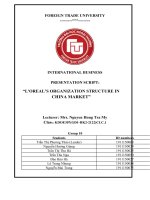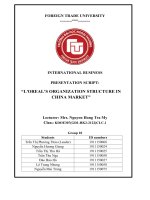(TIỂU LUẬN) INTERNATIONAL BUSINESS PRESENTATION SCRIPT LOREAL’S ORGANIZATION STRUCTURE IN CHINA MARKET
Bạn đang xem bản rút gọn của tài liệu. Xem và tải ngay bản đầy đủ của tài liệu tại đây (429.74 KB, 13 trang )
FOREIGN TRADE UNIVERSITY
---------***---------
INTERNATIONAL BUSINESS
PRESENTATION SCRIPT:
“L'OREAL’S ORGANIZATION STRUCTURE IN
CHINA MARKET”
Lecturer: Mrs. Nguyen Hong Tra My
Class: KDOE307(GĐ1-HK2-2122)CLC.1
Group 10
Students
Đào Bảo Hà
I.
Market overview and corporate introduction
1.
Chinese cosmetic market
China’s cosmetics sector has been growing rapidly in recent years, in line with the
growth of the economy. The typical cosmetic products sold in China include skincare, color
cosmetics, haircare, and toiletries. As of 2020, China became the world’s second-largest
beauty and personal care product market after the U.S. in terms of market value.
China’s demand for make-up products is maturing and diversifying. According to
Euromonitor, the size of the Chinese market for children’s cosmetics reached RMB 26.8
billion in 2020. Data from Askci Research reveal that 59.5% of the men buying cosmetics
are aged under 25. The Chinese market is also moving towards more high-end products,
especially foreign brands. Chinabaogao.com figures show that China’s market for high-end
skincare products was RMB 91.7 billion in 2020.
Integrated e-commerce platforms, department stores and specialty stores are now the
top three sales channels. E-commerce on social media platforms such as Xiaohongshu,
TikTok and Kuaishou has further stimulated spending on cosmetics.
2. L'Oréal Group
L'Oréal is a French personal care company headquartered in Clichy, Hauts-de-Seine
with a registered office in Paris. It is the world's largest cosmetics company and has
developed activities in the field concentrating on hair color, skin care, sun protection, makeup, perfume, and hair care.
The company was founded by a young French chemist, Eugène Schueller. Schueller
had already started a small commercial business called “Auréole” in 1907, which produced
hair care products (The Telegraph, 2006), purchased by Parisian hairdressers. In 1908, he
patented the product and, in 1909, founded his company Sociộtộ Franỗaise des Teintures
Inoffensives pour Cheveux”. In 1939, the company simply became known as L’Oréal.
L’Oréal now operates in 150 countries across the globe and has approximately 88,00
employees. By 1928, the company had established the subsidiary “Monsavon”, and over the
coming decades established several others, such as the Brazilian “Faproco” in 1959,
“Lancome” in 1964, “Garnier” in 1965 and “Biotherm” in 1970. By 1963, the L’Oréal
Group was listed on the Paris Stock Exchange, and its market capitalization has increased
more than 750 times since then.
According to L’Oréal’s annual results released in 2020 they made an operating profit
of 5.20 billion euros, representing 18.6% of sales. The company had a record year in sales
and profits during 2000, and L'Oréal remained the market leader in the cosmetics industry
with a 16.8% market share.
3. L'oreal Group in the Chinese market
a) L'oreal's PESTEL model in China
Political: This unease present in the business environment was somewhat lessened
with China's WTO entry in 2001, by restricting some of the business risk through the
WTO's membership requirements. Amongst some of the measures are the reduction of
import tariffs and other non-tariff barriers, as well as many others, which will help
investment to take place in a more attractive, transparent and predictable business
environment. Fears have been recently intensified by the upcoming annual plenary session
of the National People's Congress.
Economic: China has displayed impressive GDP growth as well as an overall
increase in disposable income, which often translates into greater expenditure on luxuries
like cosmetics; experts estimate an expansion of the Chinese cosmetics market of 56.5%
until 2010, reaching a total value of $2.3bn. However, one currency risk that the firm may
experience is that of the artificially low value of the renminbi, despite foreign pressure for
revaluation, meaning some 'real' value loss during currency conversion.
Social: L'Oréal will need to embrace local tastes, lifestyles and values not only in
product developments, but also in its promotion efforts. It has already signed local star
Zhang Ziyi, in order to encourage some identification on the part of the consumers. These
adaptations should be discernible within the marketing mix, which will need revising to
consider local preferences of distribution, branding and promotion.
Technological: As for the private sector, L'Oréal has funded a new scientific research
center in Shanghai, with the aim of furthering research on Asian hair and skin. This is very
important for L'Oréal, given that their competitive advantage has always been based on a
strong emphasis on R&D to ensure local sensitivity and adaptation. The cosmetic industry is
a technology-heavy one, where research and improvement is of the essence to ensure an
ongoing flow of new products and concepts, and in order to maintain an 'edge'.
Legal: The legal sphere L'Oréal will face is very much influenced by the CCP
governance, making their support crucial. Despite economic openness, the party maintains
an iron grip in the running of the country and often dictates the law in an arbitrary manner.
L'Oréal managed in the past to circumvent a few restrictions during its entry into the
Chinese market, though the skilful acquisition of 'Yue-Sai' in 2004, it has benefited from
local knowledge and expertise, as well as already established production facilities.
Environmental: L'Oréal has also not yet acknowledged the growing environmental
concerns of many consumers, and has not tapped into the emerging market for 'natural' and
'organic' products, being often perceived as more harmful and 'chemical-based'. These
changing consumer preferences have been observed in many markets, and some firms have
already seized the opportunity to close this gap (for example, L'Oréal has a relatively small
share (9.8%) in the Brazilian make-up market, whose consumers favor 'Natura', with 25.9%
market share).
b) L'oreal's SWOT model in China
fantastic product and brand portfolio.
environmental advantage.
service.
cosmetics.
skincare etc.
-
L’Oreal’s advanced research and
product development.
-
L’Oréal Paris recently launched their
Makeup Genius app.
-
Large patents registered by the
company.
II.
L'oreal's organizational structure in the Chinese market
1.
Overview of L'oreal's international business strategy
L’Oréal has positioned itself as a premium, high-quality cosmetics company that
meets the sophisticated demands of consumers. To do this, L'Oréal has continuously
researched to develop new product models and beauty formulas. Furthermore, whether
introducing a new product line or entering a new market, L'Oréal had to spend a significant
amount of money on marketing campaigns. Moreover, in the current globalization
conditions, L'Oréal has to face many other cosmetic companies from emerging countries
such as China, Japan, and Korea. L'Oreal's main competitors such as P&G, Unilever,
Kimberly Clark, Colgate-Palmolive are also trying to reform the production process, reduce
product costs, and increase global competitiveness. That also leaves L'Oréal facing huge
cost pressures. How to lower research and production costs while still competing with
competitors is always a question that L'Oreal must answer in order to survive and develop.
In addition, the cosmetic industry in China is one of the industries that is under great
pressure from consumers. Products are manufactured not only to meet the wishes of
consumers but also to fit their body structure. In addition, the product must overcome
cultural barriers and political pressure in order to capture the hearts and minds of this
country's consumers. Existing substitute products appear a lot, affecting the consumption of
the company's products. In order to reconcile that pressure, perform well and increase
competitiveness in the international market, L'Oreal has applied a transnational strategy,
which aims at expanding their sales, lowering their production costs, and also attain
economies of scale. Accordingly, L'Oreal researched the features of Europeans, Asians and
Africans before launching products that were universally suitable for people from the same
continent. At the same time, find countries with low labor costs in each continent, set up
factories, and then export manufactured products to neighboring countries in the region. As
factories in Indonesia and China have supplied products to markets in the Asia-Pacific
region such as Vietnam, Thailand, Japan, and Korea. Thanks to that, L'Oreal has overcome
geographical obstacles and lowered production costs, using regional economic advantages,
to become the world's leading cosmetics company.
In order to successfully implement the transnational strategy, the L'Oréal group has
successfully coordinated the implementation of functional strategies, the most prominent of
which is its international marketing strategy. The company has smoothly coordinated
between standardizing and adapting its marketing mix strategy, thereby solving the pressure
of reducing production costs while still meeting local needs and increasing its
competitiveness.
2. Organization structure
a) Vertical management
Globally as well as in China, L'oreal Group actually does not implement fully
centralized or fully decentralized management, but combines these two methods to provide
an effective approach.
Centralized management: The chain of command in L´Oréal is the continuous line
of authority that extends from upper organizational levels (committee and board of
directors) to the lowest levels (interns) and clarifies who reports to whom. For instance,
inside the upper levels, the board of directors make the decisions which are audited by the
committee and then the one who makes the final decision is Nicolas Hieronimus, who is
currently the CEO of L´Oréal. So we could say that authority, which refers to the rights
inherent in a managerial position to tell people what to do and to expect them to do it, is
practiced by those upper levels of L´Oréal. This really facilitates decision making and
coordination. These managers coordinate and integrate the work of employees, but we can
also make a division here because as L´Oréal is a huge company, it is worldwide, so it
divides the authority into the geographic zones having one manager for each one of them
that makes decisions regarding their zone. In China, Fabrice Megarbane, currently holding
the position of CEO is responsible for making the final decisions for the development
strategies of L'oreal in China. There are also sub managers and coordinators with different
specialized employees. Those employees assume an obligation to perform any assigned
duties regarding their field of expertise.
Decentralized management: Employees throughout the organization can access
information that used to be available only to top managers in a matter of a few seconds.
Because for L'Oreal it is very important to take into account their points of view. That's why
they have jobs such as junior manager, which is aimed at young people and enables them to
participate in the decision making together with upper levels.
Since L’Oreal plans on leading the beauty industry through innovation and capturing
strength in niche global organizations, this requires the organization to have a high number
of empowered roles and a large number of management levels within each division and
within each subsidiary they own. L’Oreal has evolved its organization to have a large
number of levels from top to bottom with CEO Nicolas Hieronimus leading the organization
forward. Below him there are 14 board members and 19 main executives who are in charge
of the organization’s operational, functional, and major geographical divisions (Executive
Committee, 2018). It is the same in China, CEO Fabrice Megarbane is on the top and and
under him there are also executives to head each product division & department. Each
management committee’s division has a large depth of hierarchy with a large number of
management levels from top to bottom and a high degree of task specialization and a high
amount of reporting levels within the department.
=> We can realize that there is clear upper level management and centralization when
making the most important decisions. However, all those decisions are based on analyzing
all the levels below: their studies, expertise, opinion and decisions. So we can also say that
it is decentralization management.
Advantages of the model:
- It is more free-flowing and adaptive that will help the organization compete competitively
in the marketplace while simultaneously empowering their employees to actively deal with
the fast changes of demands in the cosmetic marketplace;
Enhancing the role of subordinates, but executive committee still have the right to
direct;
-
Ensuring both creativity and compatibility with common goals;
-
Combines the advantages of both centralized and decentralized management models.
Potential disadvantage of the model:
-
There may be conflicts in the discussion between superiors and subordinates
b)
Horizontal management
L’Oréal’s organizational structure is a mixture of divisional and functional structures.
L’Oreal has 4 main product divisions (Consumer Products, Professional Products, L’Oreal
Luxe, and Active Cosmetics), specialist divisions (including Research and Innovation,
Human
Resources,
Sustainability,
Communications/Public Affairs,
Legal,
Retail,
Operations, Digital, and Ethics). Within each geographic and main product divisions,
L’Oreal owns many subsidiaries that provide products demanded in the area. Although
L’Oreal is a large organization with many segments, the organization uses the organic
decentralized approach. Each division has a high degree of task specialization and a high
amount of reporting levels within the department.
The company is structured as such considering the functions of work, as well as
divisions, which can be seen from the functional aspects through titles such as CIO, Finance
& Administration, Operations, etc. However, the divisional structure can clearly be
recognised through the structuration by country divisions and by product divisions, such as
Luxury Products, Consumer Products, etc. The organizational structure of L’Oréal is
therefore a rather sophisticated one, which is due to its worldwide influence, and the fact
that L’Oréal is a well-established organization.
Since L’Oreal plans on leading the beauty industry through innovation and capturing
strength in niche global organizations, this requires the organization to have a high number
of empowered roles and a large number of management levels within each division and
within each subsidiary they own. Each management committee’s division has a large depth
of hierarchy with a large number of management levels from top to bottom. Within each
level of management, there is an adaptive culture where employees are able to collaborate
and communicate horizontally to get tasks done.
Figure 1 - Divisional Organization Structure
Figure 2 - Functional Organization Structure
Advantages of the model:
This combined structure was chosen to utilize the advantages that both functional and
divisional structures offer.
-
The functional structure leads to specialization as each profession is divided into
different sections, resulting in increased levels of productivity in the work environment.
-
Another advantage observed in the functional structure is that all the employees
working within a department are experts in their field, which is beneficial for coordination
at branch level.
Potential disadvantages:
- Competition for resources between product lines can lead to counterproductive
results.
- Having difficulty in adapting to factors affecting the whole organization, needing many
people with general management and administration capabilities.
- Creates difficulties for top management control.
3. Incentive mechanism and corporate culture
Incentive mechanism
At L'Oréal, sustainable growth and the social model are inseparable. Since 2012,
L'Oréal has rolled out a set of priorities for health, social protection, work-life balance and
workplace well being across the globe. This policy enables all their teams to enjoy the same
protections and the best social practices around the world.
L'Oréal has already introduced a minimum maternity leave of 14 weeks, payments in
the case of death or permanent disability, flexible working and improved working
conditions.
In 2018, L'Oréal launched its first Employee Share Ownership Plan in over 50
countries. The plan enables all employees to support L'Oreal's development, be involved in
their strategic projects and share in their success.
Corporate culture
To better share its values with all employees, particularly those who have just joined the
Group, L’Oréal has decided that its corporate culture, thus far shared orally, needs to be
formalized in writing. This represents a significant step towards ensuring unity and growth
for the Group which is now so global and decentralized.
A company’s culture is made up of a collection of values and specific ways of doing
things that forge a feeling of belonging and pride. Communicating this culture to employees
– particularly those who have just joined the Group – enables them to share experiences and
facilitate integration. It also encourages all employees to become active participants within
the Group by bringing its culture to life and helping it evolve. This familiarity with and
appropriation of their shared set of values is the key to L’Oréal’s ability to attract and retain
talent.
In its role as the guardian of L’Oréal’s culture, Human Relations is also responsible for
ensuring that employees’ daily experiences are in line with the values it upholds. To make
sure these values are reflected in people’s actions, the Group has created a document titled
Life@L’Oréal to communicate the L’Oréal culture to new employees in a range of
instructive formats.
An attractive culture
Four pillars of the L’Oréal corporate culture which enhance the Group’s attractiveness
are outlined:
-
Constant focus on consumers, to meet and anticipate their expectations;
-
The Group’s entrepreneurial spirit and support for employees who take
initiative, everywhere and in every country;
-
The community spirit that pervades the company, which works together as a
single team despite its size;
and
The role executives play as facilitators, for whom helping employees grow
realize their potential is considered a key function.
Tools to help employees embrace the L’Oréal culture
New employees benefit from tools designed to help them better understand the
corporate culture and allow them to contribute to it. New employee orientation, known as
FIT , has been strengthened through the inclusion of events focused on our corporate culture
and strategic vision. Each new employee is also encouraged to download the new FIT
culture app. This digital coach helps employees appropriate key values through challenges,
personal stories and videos. In addition to this daily guidance, employees can also benefit
from MOOCs and corporate culture learning games.
At the same time, the Simplicity transformation programme includes seminars designed
to share the Group’s culture with executives and managers. In the Lead & Enable
programme, managers learn to help employees grow and encourage them to take initiative.
In addition, the L’Oréal Momentum programme provides opportunities to reflect on how we
can build a new, community-driven and more collaborative L’Oréal.
III.
L'oreal's business results in the Chinese market and lessons learned
1.
L'oreal's business results in the Chinese market
Year after year, the beauty market in China continues to grow , and L’Oréal had
another exceptional year there in 2019, despite an overall slowdown in the Chinese
economy. The market is benefiting from major shifts in demographics as well as emerging
trends in cosmetics. It is a fast-changing environment where consumers’ expectations are
reaching new heights but L’Oréal continues to be the number one beauty group , and
records China as its second biggest country in terms of sales.
L’Oréal provides beauty for over 100 million people in China and has seen an
expansion in the middle to upper classes as well as Millennials over the past few years.
L'Oreal had relied on its e-commerce business during lockdowns last year to reach
consumers, who lapped up hair care treatments and skin creams, but store closures hurt
sales.
Overall group sales reached 7.6 billion euros ($9.03 billion) in the second quarter, growing
by 33.5% when stripping out currency swings and acquisitions. That was up from 10.2%
like-for-like sales growth in the previous three months, and beat a consensus for 27.5%
growth cited by Credit Suisse. Hieronimus said in a statement there would be more product
launches in the second half of 2021. Operating margins rose to 19.7% of sales by the end of
the first half, with operating profit up 26.8% to 3 billion euros.
However, new consumption types are also on the rise offering new prospects for
L’Oréal. Firstly, a new, younger generation of consumers is emerging, who are seeking
exceptionally high quality products, which have a positive social impact, and
premiumisation. The Group’s brands are therefore required to respond to these needs by
adapting their offering of products and services. Secondly, the rise of China’s lower-tier
cities is creating a growing consumer landscape thanks to the rise in household incomes and
consequently consumer spending in cosmetics products. Lastly, Chinese consumers’ daily
cosmetics routines are becoming more sophisticated leading to an increase in the demand
for high-performance skincare products and more personalisation, and the makeup category
is also benefiting from this consumption upgrade.
2. Lessons learned/ Recommendation for Vietnamese cosmetic business
-
The combination of centralized and decentralized management helps L'Oreal succeed
in the Chinese market and suggests that Vietnamese businesses should also use this model.
The company should have alignment, consistency from top to bottom, and also empower
employees in order to support product research and development to adapt to the rapid
changes of the cosmetic industry.
-
Employees should be cared for, listened to or directly made decisions to increase
problem solving skills, creativity and make employees feel valued, which creates loyalty.
-
Vietnamese businesses should diversify their product lines, such as L'Oreal has 4
main product divisions (Consumer Products, Professional Products, L'Oreal Luxe, and
Active Cosmetics). This will help Vietnamese products be suitable for many different
customers. They may consider Gen Z as a potential customer.
- Enterprises should use geographical management. It ensures them adapt to changes in the
business environment of each market as well as change products to suit those markets.
